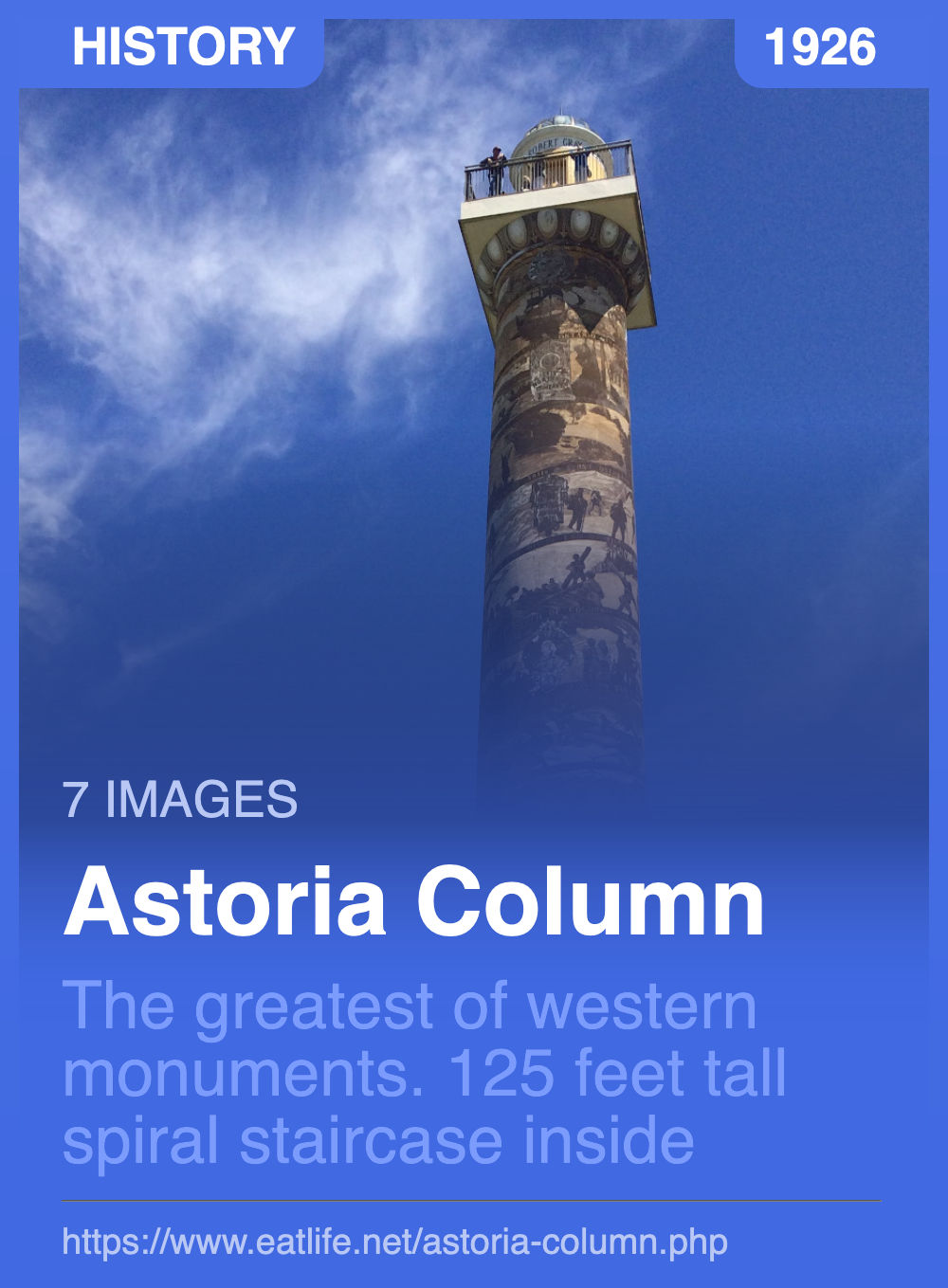T
he Astoria Column is an art-covered pillar made of concrete that reaches 125 feet skyward from Coxcomb Hill, overlooking Astoria and the Columbia River. Its observation platform offers a panoramic view for the many visitors who climb the 164 steps of its winding staircase. At its dedication on July 22, 1926, the Astoria Column was described as the "greatest of western monuments." Over the years, the Column has become an Oregon icon and a source of identity and pride for Astorians. It was listed on the National Register for Historic Places in 1974.
The exterior of the column features a spiral frieze almost seven feet wide, and if "unrolled," over 525 feet long. The mural shows 14 significant events in the early history of Oregon with a focus on Astoria. It includes Captain Gray's discovery of the Columbia River in 1792 and the Lewis and Clark Expedition. The decoration on the top is the state seal of Oregon.
https://www.atlasobscura.com/places/the-astoria-column-astoria-oregon
The United States successfully negotiated for the land in part by arguing that the U.S. government had made the most thorough exploration and settlement of the region:For 300 Years:
Spain, England, France, and Russia competed to lay claim to the land that ultimately became the greater Pacific Northwest (Oregon, Washington, Idaho and parts of Montana and Wyoming).These three accomplishments were declared to be "the trinity of epochal historical events which influenced the retention of the 'Oregon Country' as a part of the United States."
- Captain Gray had explored the area by water
- Lewis and Clark had explored it over land
- John Astor had launched commerce at Fort Astoria
The spiraling frieze on the Astoria Column tells this story, rendered by master Italian immigrant artist Attilio Pusterla. The pictoral story begins with the Clatsop and Chinook Indians and ends with the arrival of the railroad in 1893.
The Scenes:
The Astoria Column represents the history of the city of Astoria, Oregon.The text spiraling up the tower reads:
The "State of Oregon, 1859" is depicted in the final scene at the top.
- Before the White Man Came
- Robert Gray in the Ship Columbia in the Great River of the West, May 11, 1792
- Gray finds an Indian Village on the Bank of the River
- Lt. Broughton Names Mt. Hood, Oct. 1792
- The Lewis and Clark Expedition Crossing the Mountains
- Indians Greet the Explorers
- Lewis and Clark Reach the Pacific
- They Obtain Salt by Boiling Sea Water
- Fort Clatsop Established December 1805
- Fort Clatsop is Completed
- Indian Fishing and Boat Building Industry
- Astor Overland Party Leaving St. Louis
- Tonquin Sails from New York September 8, 1810
- Tonquin Arrives at Mouth of Columbia Spring 1811
- Overlanders Cross the Divide Led by Wilson Price Hunt
- Destruction of the Tonquin, Summer of 1811
- First Overland Astorians Arrive
- Arrival of Astoria to the Northwest Company, Oct. 1813
- U.S. Ship Ontairio Flying American Flag, 1818
- Coming of the Pioneers - 1837-1848
- The Railway Arrives 1893
http://columbiariverimages.com/Regions/Places/astoria_column.html
- The Astoria Column is a tower in the northwest United States
- It overlooks the mouth of the Columbia River on Coxcomb Hill in Astoria, Oregon
- Built in 1926
The tower was built in 1926 with financing by the Great Northern Railway and Vincent Astor (the great-grandson of John Jacob Astor) in commemoration of the city's role in the family's business history.
- The 125 foot tall column has a 164 step spiral staircase ascending to an observation deck at the top
- It was added to the National Register of Historic Places on May 2, 1974
- Patterned after the Trajan Column in Rome and the Place Vendome Column in Paris.
IMAGE:[]
[https://en.wikipedia.org/wiki/File:Traijan%27s_Column_2013-2.jpg]
IMAGE:[]
[https://commons.wikimedia.org/w/index.php]
- Painted by Electus D. Litchfield and Attilio Pusterla, the mural shows 14 significant events in the early history of Oregon, as well as 18 scenes from the history of the region
- Constructed of concrete, its foundation is twelve feet deep
Today
The Astoria Column attracts visitors from around the world. Pusterla's sgraffito artwork, an ancient technique in which images are engraved into wet plaster and then colored powders are hand-blown into the outlines, is a source of wonder for many. The lower bands begin with Captain Gray's arrival to the Columbia River in May 1792, and his first contact with the Chinook and Clatsop tribes. As it winds up to the top of the column, the histogram continues with the Lewis and Clark Expedition's arrival in the area, the arrival of the first European settlers, and ends with the arrival of the railroad to Astoria in 1893.

Looking up at the spiral staircase

Looking towards the ocean. Both of those bridges are the 101 Freeway


Friends of Astoria Column:

The Astoria Column was completed in 1926 by The Great Northern Railroad and Vincent Astor, great grandson of John Jacob Astor, who founded Astoria The Column is a historical monument which depicts the discovery and settlement of the Columbia Rive until the arrival of the railway.
In 1988, Friends of Astoria Column was founded to advance the cause of restoring and preserving this historically important structure, which had been severely damaged by time and weather.
On the adjacent plaque and additional plaques on each landing are listed the names of major donors and those who 'bought' a stair. Their generosity and the generosity of many others is helping us accomplish our restoration goals.
Thank You
Friends of Astoria Column
[]
[https://www.astoriaparks.com/parks/astoria_column.aspx]
[]
[https://astoriacolumn.org/]
1 Coxcomb Drive
Astoria, OR 97103










